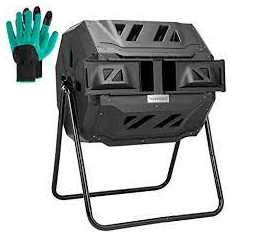Eco-Friendly Tip of the Week: Food Waste Solutions

Rotating Compost Bin – Amazon
May 4, 2021
Leftovers and spoiled produce have been estimated to add up to be about 42.8 million tons of waste which end up in landfills or combustion facilities. This can be for various reasons, whether it’s not good distribution of the food that’s produced, people buy too much food that they don’t end up eating, or no one buys the food that looks misshapen and imperfect. Due to this food waste being tossed in landfills, the likelihood of the waste decomposing decreases due to the lack of oxygen (which doesn’t allow microbes that break down the organic matter, as they need oxygen).
So what can you do?
An easy option is to buy less food. If you limit the amount of food you initially buy, there’s less waste. You can also try and eat any produce that is misshapen or just imperfect. This helps reduce your own contribution to food waste.
A harder but more effective option is to start composting. Compost helps reuse your food waste and make it into nutrients that can then be used in your own backyard. Composting allows what landfills don’t, for microorganisms to eat the organic waste, break it down, and turn it into something that creates many benefits for new crops and wildlife.
If you just collect your organic waste and layer it with some soil, while moving the pile every couple days, you can easily create your own nutrients. There are also several companies that have created easy to use compost bins that can be fitted to any amount of waste. Just some simple research can help find out what’s best for you.
Managing your own food waste can help contribute to solving a bigger problem, and anything you do helps, so always try your best.


